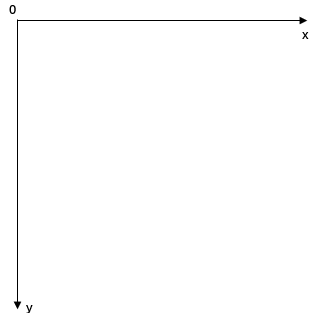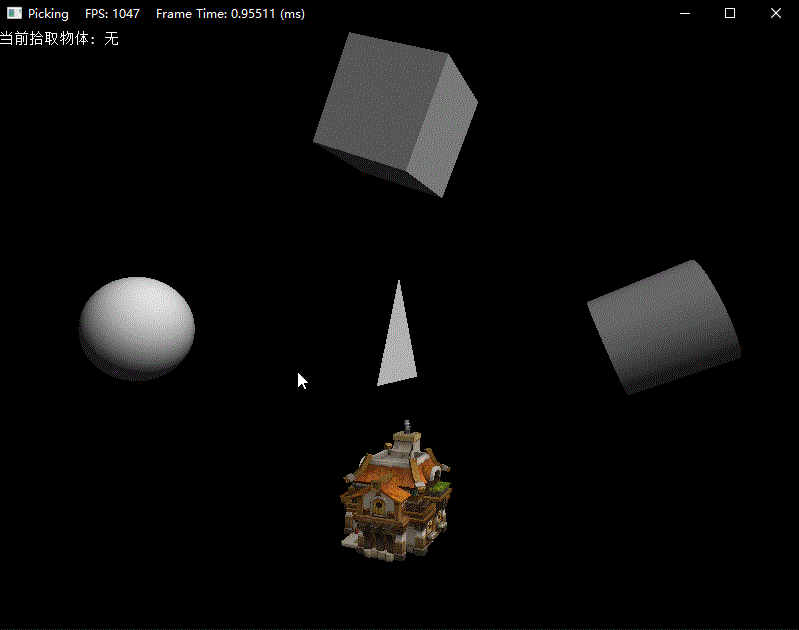DirectX11 With Windows SDK--21 滑鼠拾取
前言
由於最近在做專案,不得不大幅減慢更新速度。現在可能一個月1-2章。
拾取是一項非常重要的技術,不論是電腦上用滑鼠操作,還是手機的觸屏操作,只要涉及到UI控制元件的選取則必然要用到該項技術。除此之外,一些類似魔獸爭霸3、星際爭霸2這樣的3D即時戰略遊戲也需要通過拾取技術來選中角色。
給定在2D螢幕座標系中由滑鼠選中的一點,並且該點對應的正是3D場景中某一個物件表面的一點。 現在我們要做的,就是怎麼判斷我們選中了這個3D物件。
在閱讀本章之前,先要了解下面的內容:
| 章節 |
|---|
| 05 鍵盤和滑鼠輸入 |
| 06 DirectXMath數學庫 |
| 10 攝像機類 |
| 18 使用DirectXCollision庫進行碰撞檢測 |
DirectX11 With Windows SDK完整目錄
核心思想
龍書11上關於滑鼠拾取的數學原理講的過於詳細,這裡儘可能以簡單的方式來描述。
因為我們所能觀察到的3D物件都處於視錐體的區域,而且又已經知道攝像機所在的位置。因此在螢幕上選取一點可以理解為從攝像機發出一條射線,然後判斷該射線是否與場景中視錐體內的物體相交。若相交,則說明選中了該物件。
當然,有時候射線會經過多個物件,這個時候我們就應該選取距離最近的物體。
一個3D物件的頂點原本是位於區域性座標系的,然後經歷了世界變換、觀察變換、投影變換後,會來到NDC空間中,可視物體的深度值(z值)通常會處於0.0到1.0之間。而在NDC空間的座標點還需要經過視口變換,才會來到最終的螢幕座標系。在該座標系中,座標原點位於螢幕左上角,x軸向右,y軸向下,其中x和y的值指定了繪製在螢幕的位置,z的值則用作深度測試。而且從NDC空間到螢幕座標系的變換隻影響x和y的值,對z值不會影響。

而現在我們要做的,就是將選中的2D螢幕點按順序進行視口逆變換、投影逆變換和觀察逆變換,讓其變換到世界座標系並以攝像機位置為射線原點,構造出一條3D射線,最終才來進行射線與物體的相交。在構造螢幕一點的時候,將z值設為0.0即可。z值的變動,不會影響構造出來的射線,相當於在射線中前後移動而已。
現在回顧一下視口類D3D11_VIEWPORT的定義:
typedef struct D3D11_VIEWPORT {
FLOAT TopLeftX;
FLOAT TopLeftY;
FLOAT Width;
FLOAT Height;
FLOAT MinDepth;
FLOAT MaxDepth;
} D3D11_VIEWPORT;從NDC座標系到螢幕座標系的變換矩陣如下:
\[ \mathbf{T}=\begin{bmatrix} \frac{Width}{2} & 0 & 0 & 0 \\ 0 & -\frac{Height}{2} & 0 & 0 \\ 0 & 0 & MaxDepth - MinDepth & 0 \\ TopLeftX + \frac{Width}{2} & TopLeftY + \frac{Height}{2} & MinDepth & 1 \end{bmatrix}\]
現在,給定一個已知的螢幕座標點(x, y, 0),要實現滑鼠拾取的第一步就是將其變換回NDC座標系。對上面的變換矩陣進行求逆,可以得到:
\[ \mathbf{T^{-1}}=\begin{bmatrix} \frac{2}{Width} & 0 & 0 & 0 \\ 0 & -\frac{2}{Height} & 0 & 0 \\ 0 & 0 & \frac{1}{MaxDepth - MinDepth} & 0 \\ -\frac{2TopLeftX}{Width} - 1 & \frac{2TopLeftY}{Height} + 1 & -\frac{MinDepth}{MaxDepth - MinDepth} & 1 \end{bmatrix}\]
儘管DirectXMath沒有構造視口矩陣的函式,我們也沒必要去直接構造一個這樣的矩陣,因為上面的矩陣實際上可以看作是進行了一次縮放和平移,即對向量進行了一次乘法和加法:
\[\mathbf{v}_{ndc} = \mathbf{v}_{screen} \cdot \mathbf{scale} + \mathbf{offset}\]
\[\mathbf{scale} = (\frac{2}{Width}, -\frac{2}{Height}, \frac{1}{MaxDepth - MinDepth}, 1)\]
\[\mathbf{offset} = (-\frac{2TopLeftX}{Width} - 1, \frac{2TopLeftY}{Height} + 1, -\frac{MinDepth}{MaxDepth - MinDepth}, 0)\]
由於可以從之前的Camera類獲取當前的投影變換矩陣和觀察變換矩陣,這裡可以直接獲取它們並進行求逆,得到在世界座標系的位置:
\[\mathbf{v}_{world} = \mathbf{v}_{ndc} \cdot \mathbf{P}^{-1} \cdot \mathbf{V}^{-1} \]
射線類Ray
Ray類的定義如下:
struct Ray
{
Ray();
Ray(const DirectX::XMFLOAT3& origin, const DirectX::XMFLOAT3& direction);
static Ray ScreenToRay(const Camera& camera, float screenX, float screenY);
bool Hit(const DirectX::BoundingBox& box, float* pOutDist = nullptr, float maxDist = FLT_MAX);
bool Hit(const DirectX::BoundingOrientedBox& box, float* pOutDist = nullptr, float maxDist = FLT_MAX);
bool Hit(const DirectX::BoundingSphere& sphere, float* pOutDist = nullptr, float maxDist = FLT_MAX);
bool XM_CALLCONV Hit(DirectX::FXMVECTOR V0, DirectX::FXMVECTOR V1, DirectX::FXMVECTOR V2, float* pOutDist = nullptr, float maxDist = FLT_MAX);
DirectX::XMFLOAT3 origin; // 射線原點
DirectX::XMFLOAT3 direction; // 單位方向向量
};其中靜態方法Ray::ScreenToRay執行的正是滑鼠拾取中射線構建的部分,其實現靈感來自於DirectX::XMVector3Unproject函式,它通過給定在螢幕座標系上的一點、視口屬性、投影矩陣、觀察矩陣和世界矩陣,來進行逆變換,得到在物體座標系的位置:
inline XMVECTOR XM_CALLCONV XMVector3Unproject
(
FXMVECTOR V,
float ViewportX,
float ViewportY,
float ViewportWidth,
float ViewportHeight,
float ViewportMinZ,
float ViewportMaxZ,
FXMMATRIX Projection,
CXMMATRIX View,
CXMMATRIX World
)
{
static const XMVECTORF32 D = { { { -1.0f, 1.0f, 0.0f, 0.0f } } };
XMVECTOR Scale = XMVectorSet(ViewportWidth * 0.5f, -ViewportHeight * 0.5f, ViewportMaxZ - ViewportMinZ, 1.0f);
Scale = XMVectorReciprocal(Scale);
XMVECTOR Offset = XMVectorSet(-ViewportX, -ViewportY, -ViewportMinZ, 0.0f);
Offset = XMVectorMultiplyAdd(Scale, Offset, D.v);
XMMATRIX Transform = XMMatrixMultiply(World, View);
Transform = XMMatrixMultiply(Transform, Projection);
Transform = XMMatrixInverse(nullptr, Transform);
XMVECTOR Result = XMVectorMultiplyAdd(V, Scale, Offset);
return XMVector3TransformCoord(Result, Transform);
}將其進行提取修改,用於我們的Ray物件的構造:
Ray Ray::ScreenToRay(const Camera & camera, float screenX, float screenY)
{
//
// 節選自DirectX::XMVector3Unproject函式,並省略了從世界座標系到區域性座標系的變換
//
// 將螢幕座標點從視口變換回NDC座標系
static const XMVECTORF32 D = { { { -1.0f, 1.0f, 0.0f, 0.0f } } };
XMVECTOR V = XMVectorSet(screenX, screenY, 0.0f, 1.0f);
D3D11_VIEWPORT viewPort = camera.GetViewPort();
XMVECTOR Scale = XMVectorSet(viewPort.Width * 0.5f, -viewPort.Height * 0.5f, viewPort.MaxDepth - viewPort.MinDepth, 1.0f);
Scale = XMVectorReciprocal(Scale);
XMVECTOR Offset = XMVectorSet(-viewPort.TopLeftX, -viewPort.TopLeftY, -viewPort.MinDepth, 0.0f);
Offset = XMVectorMultiplyAdd(Scale, Offset, D.v);
// 從NDC座標系變換回世界座標系
XMMATRIX Transform = XMMatrixMultiply(camera.GetViewXM(), camera.GetProjXM());
Transform = XMMatrixInverse(nullptr, Transform);
XMVECTOR Target = XMVectorMultiplyAdd(V, Scale, Offset);
Target = XMVector3TransformCoord(Target, Transform);
// 求出射線
XMFLOAT3 direction;
XMStoreFloat3(&direction, XMVector3Normalize(Target - camera.GetPositionXM()));
return Ray(camera.GetPosition(), direction);
}此外,在構造Ray物件的時候,還需要預先檢測direction是否為單位向量:
Ray::Ray(const DirectX::XMFLOAT3 & origin, const DirectX::XMFLOAT3 & direction)
: origin(origin)
{
// 射線的direction長度必須為1.0f,誤差在10e-5f內
XMVECTOR dirLength = XMVector3Length(XMLoadFloat3(&direction));
XMVECTOR error = XMVectorAbs(dirLength - XMVectorSplatOne());
assert(XMVector3Less(error, XMVectorReplicate(10e-5f)));
XMStoreFloat3(&this->direction, XMVector3Normalize(XMLoadFloat3(&direction)));
}構造好射線後,就可以跟各種碰撞盒(或三角形)進行相交檢測了:
bool Ray::Hit(const DirectX::BoundingBox & box, float * pOutDist, float maxDist)
{
float dist;
bool res = box.Intersects(XMLoadFloat3(&origin), XMLoadFloat3(&direction), dist);
if (pOutDist)
*pOutDist = dist;
return dist > maxDist ? false : res;
}
bool Ray::Hit(const DirectX::BoundingOrientedBox & box, float * pOutDist, float maxDist)
{
float dist;
bool res = box.Intersects(XMLoadFloat3(&origin), XMLoadFloat3(&direction), dist);
if (pOutDist)
*pOutDist = dist;
return dist > maxDist ? false : res;
}
bool Ray::Hit(const DirectX::BoundingSphere & sphere, float * pOutDist, float maxDist)
{
float dist;
bool res = sphere.Intersects(XMLoadFloat3(&origin), XMLoadFloat3(&direction), dist);
if (pOutDist)
*pOutDist = dist;
return dist > maxDist ? false : res;
}
bool XM_CALLCONV Ray::Hit(FXMVECTOR V0, FXMVECTOR V1, FXMVECTOR V2, float * pOutDist, float maxDist)
{
float dist;
bool res = TriangleTests::Intersects(XMLoadFloat3(&origin), XMLoadFloat3(&direction), V0, V1, V2, dist);
if (pOutDist)
*pOutDist = dist;
return dist > maxDist ? false : res;
}至於射線與網格模型的拾取,有三種實現方式,對精度要求越高的話效率越低:
- 將網格模型單個OBB盒(或AABB盒)與射線進行相交檢測,精度最低,但效率最高;
- 將網格模型劃分成多個OBB盒,分別於射線進行相交檢測,精度較高,效率也比較高;
- 將網格模型的所有三角形與射線進行相交檢測,精度最高,但效率最低。而且模型面數越大,效率越低。這裡可以先用模型的OBB(或AABB)盒與射線進行大致的相交檢測,若在包圍盒內再跟所有的三角形進行相交檢測,以提升效率。
在該演示教程中只考慮第1種方法,剩餘的方法根據需求可以自行實現。
最後是一個專案演示動圖,該專案沒有做點選物體後的反應。滑鼠放到這些物體上會當即顯示出當前所拾取的物體。其中立方體和房屋使用的是OBB盒。

